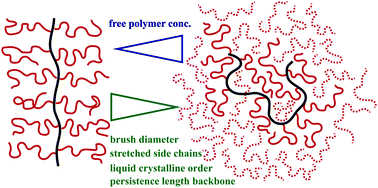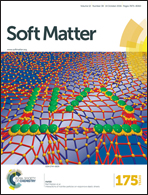Loss of bottlebrush stiffness due to free polymers†
Abstract
A recently introduced DNA-bottlebrush system, which is formed by the co-assembly of DNA with a genetically engineered cationic polymer-like protein, is subjected to osmotic stress conditions. We measured the inter-DNA distances by X-ray scattering. Our co-assembled DNA-bottlebrush system is one of the few bottlebrushes known to date that shows liquid crystalline behaviour. The alignment of the DNA bottlebrushes was expected to increase with imposed pressure, but interestingly this did not always happen. Molecularly detailed self-consistent field calculations targeted to complement the experiments, focused on the role of molecular crowding on the induced persistence length lp due to the side chains and the cross-sectional width D of the molecular bottlebrushes. Both the thickness as well as the backbone persistence length drop with increasing protein–polymer bulk concentrations and dramatic effects are found above the overlap threshold. The flexibilisation is more significant and therefore the bottlebrush aspect ratio, lp/D, decreases with protein–polymer concentration. This loss in aspect ratio is yet another argument why molecular bottlebrushes rarely order in anisotropic phases and may explain why bottlebrushes are excellent lubricants.


 Please wait while we load your content...
Please wait while we load your content...